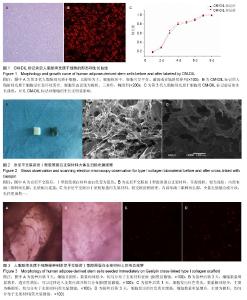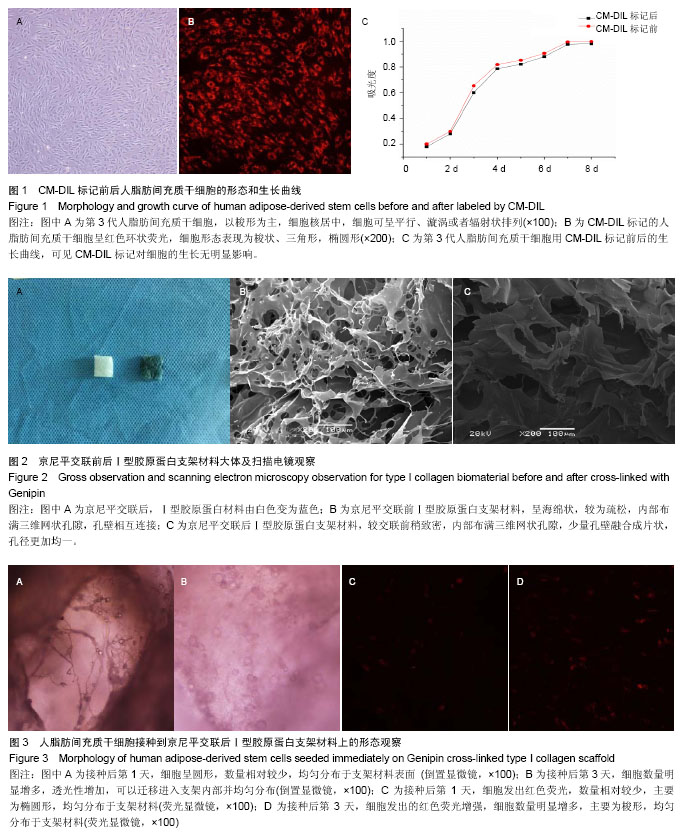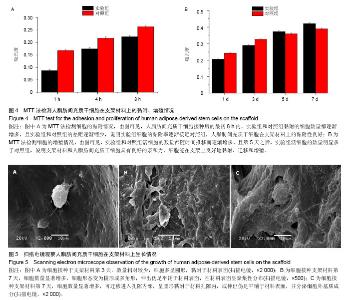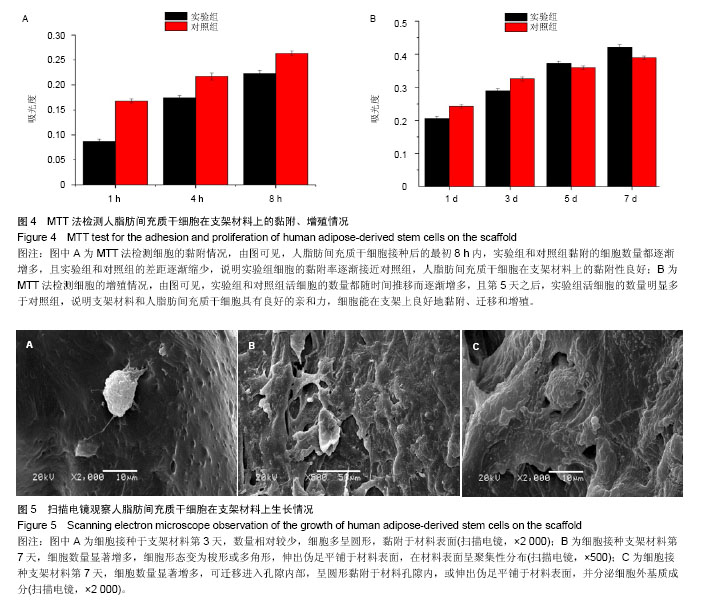| [1] Itoi Y, Takatori M, Hyakusoku H,et al.Comparison of readily available scaffolds for adipose tissue engineering using adipose-derived stem cells.J Plast Reconstr Aesthet Surg. 2010;63(5):858-864.
[2] Mohammadi H, Janmey PA, McCulloch CA.Lateral boundary mechanosensing by adherent cells in a collagen gel system.Biomaterials. 2014;35(4):1138-1149.
[3] Grant ME. From collagen chemistry towards cell therapy - a personal journey.Int J Exp Pathol. 2007;88(4):203-214.
[4] He Q, Zhao Y, Chen B,et al.Improved cellularization and angiogenesis using collagen scaffolds chemically conjugated with vascular endothelial growth factor.Acta Biomater. 2011; 7(3):1084-1093.
[5] Tsuji W, Inamoto T, Yamashiro H,et al.Adipogenesis induced by human adipose tissue-derived stem cells.Tissue Eng Part A. 2009;15(1):83-93.
[6] Sung HW, Huang RN, Huang LL, et al.Feasibility study of a natural crosslinking reagent for biological tissue fixation.J Biomed Mater Res. 1998;42(4):560-567.
[7] Zhang X, Chen X, Yang T,et al.The effects of different crossing-linking conditions of genipin on type I collagen scaffolds: an in vitro evaluation.Cell Tissue Bank. 2014. [Epub ahead of print]
[8] Gimble JM, Katz AJ, Bunnell BA. Adipose-derived stem cells for regenerative medicine.Circ Res. 2007;100(9):1249-1260.
[9] Bassi G, Pacelli L, Carusone R,et al.Adipose-derived stromal cells (ASCs).Adipose-derived stromal cells (ASCs).Transfus Apher Sci. 2012;47(2):193-198.
[10] Caplan AI, Dennis JE.Mesenchymal stem cells as trophic mediators.J Cell Biochem. 2006;98(5):1076-1084.
[11] 翟羽佳,仉红刚.脂肪来源间充质干细胞体外定向诱导分化血管细胞的研究进展[J].中国生物工程杂志, 2010, 30(6): 134-138.
[12] Moseley TA, Zhu M, Hedrick MH.Adipose-derived stem and progenitor cells as fillers in plastic and reconstructive surgery.Plast Reconstr Surg. 2006;118(3 Suppl):121S-128S.
[13] Wilke A, Orth J, Lomb M, et al.Biocompatibility analysis of different biomaterials in human bone marrow cell cultures.J Biomed Mater Res. 1998;40(2):301-306.
[14] 张卫泽,李国庆,陈永清,等.人脂肪间充质干细胞的分离培养及其遗传稳定性[J].中国组织工程研究与临床康复, 2009, 13(40): 7833-7837.
[15] Vallée M, Côté JF, Fradette J.Adipose-tissue engineering: taking advantage of the properties of human adipose-derived stem/stromal cells.Pathol Biol (Paris). 2009;57(4):309-317.
[16] Wu CH, Lee FK, Suresh Kumar S,et al.The isolation and differentiation of human adipose-derived stem cells using membrane filtration.Biomaterials. 2012;33(33):8228-8239.
[17] Koellensperger E, Lampe K, Beierfuss A,et al.Intracutaneously injected human adipose tissue-derived stem cells in a mouse model stay at the site of injection.J Plast Reconstr Aesthet Surg. 2014. pii: S1748-6815(14) 00106-5.
[18] 张云松,高建华,鲁峰,等.Ⅰ型胶原支架材料与人脂肪干细胞体外生物相容性研究[J]. 南方医科大学学报, 2007, 27(2): 223-225.
[19] Di Lullo GA, Sweeney SM, Korkko J,et al.Mapping the ligand-binding sites and disease-associated mutations on the most abundant protein in the human, type I collagen.J Biol Chem. 2002;277(6):4223-4231.
[20] Sano H, Orbay H, Terashi H, et al.Acellular adipose matrix as a natural scaffold for tissue engineering.J Plast Reconstr Aesthet Surg. 2014;67(1):99-106.
[21] Daei-Farshbaf N, Ardeshirylajimi A, Seyedjafari E,et al. Bioceramic-collagen scaffolds loaded with human adipose-tissue derived stem cells for bone tissue engineering. Mol Biol Rep. 2014;41(2):741-749.
[22] 王学川,宗奕珊,强涛涛.胶原蛋白的改性原理及其应用研究进展 [J].陕西科技大学学报(自然科学版), 2013, 31(5): 28-34.
[23] 王旻,笪琳萃,谢艳,等.京尼平作为交联剂在天然生物材料改性中的应用[J].中国修复重建外科杂志, 2013, 27(5): 580-585.
[24] Chen YS, Chang JY, Cheng CY,et al.An in vivo evaluation of a biodegradable genipin-cross-linked gelatin peripheral nerve guide conduit material.Biomaterials. 2005;26(18):3911-3918.
[25] Chiono V, Pulieri E, Vozzi G,et al.Genipin-crosslinked chitosan/gelatin blends for biomedical applications.J Mater Sci Mater Med. 2008;19(2):889-898.
[26] 李令锦,李俊嵩,王东,等.京尼平对丝素蛋白交联的染色作用[J].应用与环境生物学报,2009,15(6): 799-802.
[27] Ercan E, Bagla AG, Aksoy A,et al.In vitro protection of adipose tissue-derived mesenchymal stem cells by erythropoietin.Acta Histochem. 2014;116(1):117-125.
[28] 黎洪棉,高建华,鲁峰,等.海绵状Ⅰ型胶原蛋白与兔脂肪干细胞的生物相容性[J].中国组织工程研究与临床康复, 2009, 13(25): 4829-4833. |



